RF Ideas BUPCPROXA100 125 kHz Base ID Transmitter User Manual Operational Manual
RF Ideas Inc 125 kHz Base ID Transmitter Operational Manual
RF Ideas >
Operational Manual

AIR ID®
Software
For use with pcProx TM, and AIR ID LT
Proximity Readers
User’s Manual
www.RFIDeas.com
AIR ID
END-USER LICENSE AGREEMENT
End-User License Agreement for RF IDeasTM SOFTWARE and HARDWARE - RF
IDeas’ AIR ID® , AIR ID® LT, and pcProx Proximity Activated Systems.
IMPORTANT-READ CAREFULLY: This End-User License Agreement ("EULA") is
a legal agreement between you (either an individual or a single entity) and the
manufacturer RF IDeas ("Manufacturer") with which you acquired the RF IDeas
software and hardware product(s) identified above ("PRODUCT"). The PRODUCT
includes the pcProx Base Unit, AIR ID Badge, AIR ID Base Unit or AIR ID LT
Badge, AIR ID LT Base, computer software, the associated media, any printed
materials, and any "online" or electronic documentation. By installing, copying or
otherwise using the PRODUCT, you agree to be bound by the terms of this EULA.
The SOFTWARE PORTION OF THE PRODUCT includes the computer software,
the associated media, any printed materials, and any "online" or electronic
documentation. By installing, copying or otherwise using the PRODUCT, you
agree to be bound by the terms of this EULA. If you do not agree to the terms of
this EULA, RF IDeas is unwilling to license the PRODUCT to you. In such event,
you may not use or copy the SOFTWARE PORTION OF THE PRODUCT, and you
should promptly contact the vendor you obtained this PRODUCT from for
instructions on return of the unused product(s) for a refund.
The products described in this publication are intended for consumer applications.
AIR ID and AIR ID LT operate on shared radio channels. Radio interference can
occur in any place at any time, and thus the communications link may not be
absolutely reliable. AIR ID and AIR ID LT must be used so that a loss of
communications due to radio interference or otherwise will not endanger either
people or property, and will not cause the loss of valuable data. RF IDeas assumes
no liability for the performance of product. RF IDeas products are not suitable for
use in life-support applications, biological hazard applications, nuclear
control applications, or radioactive areas. None of these products or
components, software or hardware, are intended for applications that provide
life support or any critical function necessary for the support of protection of
life, property or business interests. The user assumes responsibility for the use
of any of these products in any such application. RF IDeas, Inc. shall not be liable
for losses due to failure of any of these products, or components of these products,
beyond the RF IDeas commercial warranty, limited to the original purchase price.
SOFTWARE PRODUCT LICENSE
The PRODUCT is protected by copyright laws and international copyright treaties,
as well as other intellectual property laws and treaties. The SOFTWARE
PORTION OF THE PRODUCT is licensed, not sold.
1. GRANT OF LICENSE. This EULA grants you the following rights:
* Software. You may install and use one copy of the SOFTWARE PORTION OF
THE PRODUCT on the COMPUTER.
* Network Services. If the SOFTWARE PORTION OF THE PRODUCT includes
functionality that enables the COMPUTER to act as a network server, any number
of computers or workstations may access or otherwise utilize the basic network
services of that server. The basic network services are more fully described in the
printed materials accompanying the SOFTWARE PORTION OF THE PRODUCT.
* Storage/Network Use. You may also store or install a copy of the computer
SOFTWARE PORTION OF THE PRODUCT on the COMPUTER to allow your
other computers to use the SOFTWARE PORTION OF THE PRODUCT over an
internal network, and distribute the SOFTWARE PORTION OF THE PRODUCT to
your other computers over an internal network. However, you must acquire and
dedicate a license for the SOFTWARE PORTION OF THE PRODUCT for each
computer on which the SOFTWARE PORTION OF THE PRODUCT is used or to
which it is distributed. A license for the SOFTWARE PORTION OF THE
PRODUCT may not be shared or used concurrently on different computers.
2. DESCRIPTION OF OTHER RIGHTS AND LIMITATIONS.
* Limitations on Reverse Engineering, Decompilation and Disassembly. You may
not reverse engineer, decompile, or disassemble the PRODUCT, except and only
to the extent that such activity is expressly permitted by applicable law
notwithstanding this limitation.
* Separation of Components. The PRODUCT is licensed as a single product. Its
component parts may not be separated for use on more than one computer.
* Single COMPUTER. The PRODUCT is licensed with the COMPUTER as a
single integrated product. The PRODUCT may only be used with the COMPUTER.
* Rental. You may not rent or lease the PRODUCT without permission from RF
IDeas.
* Software Transfer. You may permanently transfer all of your rights under this
EULA only as part of a sale or transfer of the COMPUTER, provided you retain no
copies, you transfer all of the PRODUCT (including all component parts, the media
and printed materials, any upgrades, this EULA and, if applicable, the Certificate(s)
of Authenticity), AND the recipient agrees to the terms of this EULA. If the
PRODUCT is an upgrade, any transfer must include all prior versions of the
PRODUCT.
* Termination. Without prejudice to any other rights, RF IDeas may terminate this
EULA if you fail to comply with the terms and conditions of this EULA. In such
event, you must destroy all copies of the SOFTWARE PORTION OF THE
PRODUCT and all of its component parts.
3. UPGRADES. If the SOFTWARE PORTION OF THE PRODUCT is an upgrade
from another product, whether from RF IDeas or another supplier, you may use or
transfer the PRODUCT only in conjunction with that upgraded product, unless you
destroy the upgraded product. If the SOFTWARE PORTION OF THE PRODUCT
is an upgrade of a RF IDeas product, you now may use that upgraded product
only in accordance with this EULA. If the SOFTWARE PORTION OF THE
PRODUCT is an upgrade of a component of a package of software programs
which you licensed as a single product, the SOFTWARE PORTION OF THE
PRODUCT may be used and transferred only as part of that single product
package and may not be separated for use on more than one computer.
4. OEM COPYRIGHT. All title and copyrights in and to the PRODUCT (including
but not limited to any images, photographs, animations, video, audio, music, text
and "applets," incorporated into the PRODUCT), the accompanying printed
materials, and any copies of the SOFTWARE PORTION OF THE PRODUCT, are
owned by RF IDeas or its suppliers. The PRODUCT and SOFTWARE PORTION
OF THE PRODUCT is protected by copyright laws and international treaty
provisions. You may not copy the printed materials accompanying the PRODUCT.
5. DUAL-MEDIA SOFTWARE. You may receive the SOFTWARE PORTION OF
THE PRODUCT in more than one medium. Regardless of the type or size of
medium you receive, you may use only one medium that is appropriate for your
single computer. You may not use or install the other medium on another
computer. You may not loan, rent, lease, or otherwise transfer the other medium to
another user, except as part of the permanent transfer (as provided above) of the
SOFTWARE PORTION OF THE PRODUCT.
6. OEM PRODUCT SUPPORT. Product support for the PRODUCT is NOT
provided by RF IDeas Inc. or its subsidiaries. For product support, please refer to
AIR ID
the OEM suppliers support number provided in the documentation. Should you
have any questions concerning this EULA, or if you desire to contact OEM for any
other reason, please refer to the address provided in the documentation provided.
FOR THE LIMITED WARRANTIES AND SPECIAL PROVISIONS PERTAINING
TO YOUR PARTICULAR JURISDICTION, PLEASE REFER TO YOUR
WARRANTY BOOKLET INCLUDED WITH THIS PACKAGE OR PROVIDED WITH
THE SOFTWARE PRODUCT PRINTED MATERIALS.
Limited Warranty
RF IDeas, Inc. warrants to the original buyer of this product, that the hardware and
related disk(s) are free of defects in material and workmanship for a period of one
year from date of purchase from RF IDeas or from an authorized RF IDeas dealer.
Should the RF IDeas products fail to be in good working order at any time during
the one-year period, RF IDeas will, at its option, repair or replace the product at no
additional charge, provided that the product has not been abused, misused,
repaired or modified. This warranty shall be limited to repair or replacement and in
no event shall RF IDeas be liable for any loss of profit or any commercial or other
damages, including but not limited to special, incidental, consequential or other
similar claims.
No dealer, distributor, company, or person has been authorized to change or add
to the terms of this agreement, and RF IDeas will not be bound by any
representation to the contrary. RF IDeas SPECIFICALLY DISCLAIMS ALL
OTHER WARRANTIES, EXPRESSED OR IMPLIED, INCLUDING BUT NOT
LIMITED TO IMPLIED WARRANTIES OF MERCHANTABILITY AND FITNESS OF
PURPOSE. Since some states do not allow such exclusion of limitation of
incidental or consequential damages for consumer products, check the statute of
the state in which your business resides. This warranty gives you the specific legal
rights in addition to any rights that you have under the laws of the state in which
your business resides or operates.
Returns
RF IDeas products which require Limited Warranty service during the warranty
period shall be delivered to the nearest authorized dealer or sent directly to RF
IDeas at the address below with proof of purchase and a Return Materials
Authorization (RMA) Number provided by RF IDeas technical support Dept.
Replacement parts or complete boards become the property of RF IDeas.
If the returned board or unit is sent by mail, the purchaser agrees to pre-pay the
shipping charges and insure the board or unit or assume the risk of loss or damage
which may occur in transit. The purchaser is expected to employ a container
equivalent to the original packaging.
Copyright
Copyright by RF IDeas, Inc. 1997-2000. All rights reserved. Reproduction or
distribution of this document in whole or in part or in any form is prohibited without
express written permission from RF IDeas, Inc.
Trademarks
All RF IDeas products are trademarks of RF IDeas, Inc. All other product names or
names are trademarks or registered trademarks of their respective holders.
Disclaimer
This User’s Guide is printed in the U.S.A. Any resemblance mentioned in the
User’s guide to persons living or dead, or to actual corporations or products is
purely coincidental. RF IDeas believes that the information contained in this
manual is correct. However, RF IDeas does not assume any responsibility for the
accuracy of the content of this User Manual, nor for any patent infringements or
other rights of third parties. RF IDeas reserves the right to make any modifications
in either product or the manual without giving prior written notification.
AIR ID
Congratulations on the purchase of your AIR ID system. We at
RF IDeas hope you enjoy using your new AIR ID Proximity
Activated Identification System as much as we enjoyed creating
and developing it! Please share your comments and suggestions
for our future "AIR ID AWARE" solutions!
If you are interested in our OEM or Independent Developer’s
Programs, please call!
Thank you,
The Staff at RF IDeas
Need Assistance?
Call Toll-free: (847) 520-7900
Fax: (413) 581-3004
E-mail: TechSupp@RFIDeas.com
Mail to:
RF IDeas
320 Lexington Dr.
Buffalo Grove, IL 60089-6930
pcProx Base Unit FCC compliance statement
FCC ID(s)
HID version M9MBUPCPROXH100,
AWID version M9MBUPCPROXA100, or
Motorola version M9MBUPCPROXM100
This device complies with Part 15 of the FCC rules. Operation is
subject to the following two conditions: (1) This device may not
cause harmful interface, and (2) This device must accept any
interference that may cause undesired operation.
TABLE OF CONTENTS
END-USER LICENSE AGREEMENT_______________ 1
SOFTWARE PRODUCT LICENSE _________________ 1
Limited Warranty ________________________________ 3
pcProx Base Unit FCC compliance statement _________ 5
Proximity Activated Products_______________________ 9
AIR ID ® LT (Active Badge) ____________________________ 10
pcProx TM (Passive Badge) ______________________________ 10
What’s New In Version 3_________________________ 10
Windows 9X Security Layer ________________________ 10
Auto-Enrollment__________________________________ 11
Common Logon Account ___________________________ 11
Admin Badge Override ____________________________ 12
Understanding Wireless Identification ______________ 12
What is AIR ID® Proximity Activated Identification? 12
Why is it necessary?_____________________________ 12
Who can benefit using the System?_______________ 12
What is pcProx TM Proximity Activated Identification?
________________________________________________ 13
What is included with the pcProxH Kit? ___________ 14
What are the minimum system requirements? _________ 15
Hardware Installation ___________________________ 16
Windows 95B/98 Users ________________________________ 16
Windows NT Users____________________________________ 16
pcProx Badge (Passive badge users only) __________________ 17
Software Installation ____________________________ 18
Software Setup _________________________________ 19
Enable the AIR ID screen saver in Windows 9x ____ 19
Enable the AIR ID screen saver in Windows NT/2K_19
AIR ID
Windows 95B/98 Security Layer Operation _________23
Setting AIR ID System Parameters_________________25
AIR ID Startup Screen (First Time Users)___________26
AIR ID Application (Standard Launch) _____________ 27
Base Unit Dialog Tab ____________________________ 28
Base Unit Com Port ______________________________28
Get Base Version_________________________________29
Screen Saver Wait Time (seconds)_________________29
Screen Saver Wait Time when no Base Unit Attached
_________________________________________________30
Select Screen Saver Bitmap_______________________30
Badges Dialog Tab ______________________________ 31
Overview ________________________________________31
Types of Users___________________________________31
Administrative Users___________________________________ 31
Non-Badge Users______________________________________ 32
AIR ID Badge Users ___________________________________ 32
Set (Changing) Password_________________________32
Check ___________________________________________32
Reading a Badge ______________________________________ 33
Administrative Functions _______________________________ 34
Add User ________________________________________35
Edit User ________________________________________37
Delete User ______________________________________38
Audit Log________________________________________39
Audit _______________________________________________ 40
Assignment______________________________________41
Machines ________________________________________42
Admin Badge ____________________________________43
Screensaver Lock ________________________________44
Common Logon___________________________________ 45
About Dialog Tab _______________________________ 46
Initial Steps Dialog Tab__________________________ 48
Login Settings Dialog Tab ________________________ 49
NT GINA ________________________________________ 50
TROUBLESHOOTING __________________________ 51
No Base Unit Attached ___________________________ 51
Cannot Locate the Badge ________________________ 51
Your Password doesn’t work _____________________ 51
TECHNICAL SPECIFICATIONS _________________ 52
The AIR ID Base Unit__________________________________ 52
The AIR ID Badge ____________________________________ 52
The pcProx Base Unit __________________________________ 52
Index _________________________________________ 53
9Proximity Activated Products
AIR ID
Proximity Activated Products
RF IDeas offers a variety of wireless products for hands-free or
contactless identification and security. Please review the following
to choose which product best fits your need. If you do not see a
solution, please contact us. There are several software developers
licensing our technology and the solution you are looking for may
already be developed. We welcome your suggestions!

What’s New In Version 3 10
RF IDeas
Product FEATURE - BENEFIT
AIR ID ® LT (Active
Badge) ♦ Great for multiple users sharing a
computer
♦ Economical solution
♦ Badge transmits, Base Unit receives
♦ Audit Trail
♦ TD2FTM Two-Factor Authentication
pcProx TM (Passive
Badge) ♦ Great for multiple users sharing a
computer
♦ Passive badges, no batteries
contactless range is 1- 2 inches.
♦ Economical solution
♦ Uses existing passive HID or Motorola
RFID proximity technology
♦ Unique learn mode reads ID from HID or
Motorola Indala badges
♦ Audit Trail
♦ TD2FTM Two-Factor Authentication
Enterprise
Management
Software
♦ Centralized Management of all users
♦ Lowers cost of ownership
AIR ID Developer’s
Kit ♦ Complete API Kit supporting AIR ID, AIR
ID LT, and pcProx
♦ Platform independent
♦ Dynamic range adjustment
♦ Read/write ability with AIR ID
♦ Private label
♦ AIR ID Aware Certification Program
3rd Party AIR ID
Aware Products ♦ Sun Solaris Desktop Security
♦ Apple Macintosh Desktop Security
♦ Machine Control Active X controls
♦ People Location System
♦ Healthcare Security Products
What’s New In Version 3
The AIR ID software together with the pcProx reader represents a
system is greatly expanded with the release of Version 3.
Windows 9X Security Layer
The release of the Windows 95/98 security layer brings NT style
security the Windows 95/98 environments. Previously users could
simply press the ESC key and gain access to a desktop computer
running under the Windows 95/98 operating system.
11 What’s New In Version 3
AIR ID
Using the AIR ID Windows 9x security layer, users are now
required to logon using either a manual password, their proximity
card, or both. The logon is accomplished using a Ctrl-Alt-Del
keystroke sequence, similar to Windows NT/2000.
Once you press Ctrl-Alt-Del you are presented with a logon dialog
box requesting your username, password, and domain credentials.
It is important to understand that AIR ID does not perform the
authentication. The operating system or the authentication server
provides this functionality.
After the logon sequence is accepted, the user is presented with
their desktop.
The self-locking screensaver is integrated into this security layer.
In the locked mode, all applications are left in memory and
executing as before. A screen saver bitmap file is displayed and
the keyboard and mouse are locked. The proximity card can be
set to be auto-detected, and the desktop is returned. Alternately,
the user may enter their credentials manually or an administrator
may present an admin override (described below) badge.
Once the logon credentials are presented (either manually or via
the proximity token) the local and network connections are
established.
Auto-Enrollment
New software features include the ability to automatically enroll
users already established in a Windows 9x/NT client or Windows
NT server. Once the software is installed and the machine is
rebooted, an authorized user correctly entering their credentials
with their proximity card on the reader will be automatically
enrolled. This greatly reduces costs associated with the
deployment of the AIR ID system.
Common Logon Account
This feature greatly aids environments where several users share
a desktop and these users all run the same applications
throughout the day.
Users can now share a single logon account while maintaining
their individual identity. This mode provides a single account used
for logon, however the AIR ID audit log will keep track of the
Understanding Wireless Identification 12
RF IDeas
individual user at the desktop with a date/time stamp. The
features increases productivity since there is no need to re-logon
and re-load applications each time a different user needs to
access the desktop applications.
Admin Badge Override
The "admin" user may now be assigned a Badge ID to provide
override capability for access to Locked Workstations. The
security layers will now scan for users of the workstation as well as
the "admin" user. The ADMIN user is not considered until there is
at least one other user assigned to the machine. The ADMIN user
is considered part of the Common Logon set of users when the
Common Logon feature is enabled.
Understanding Wireless Identification
What is AIR ID® Proximity Activated Identification?
AIR ID (software) together with a proximity reader makes up a
proximity activated access control system that tells the PC when
the authorized user is present. Unlike password systems,
biometrics readers, and smart cards, this system uses the user’s
proximity cards, giving the PC the ability to detect when the user
has left the area with their card. Once removed, the PC is
automatically locked. When the user returns, the authenticating
information is exchanged between the pcProx Base Unit attached
to the PC and the proximity ID card. The result is a complete lock
and reactivation of access to the PC!
Why is it necessary?
With the proliferation of PC’s, cash machines, security systems,
and electronic locks, users are increasingly burdened with the
requirement of entering passwords and PINs (person identification
numbers) to gain access to these protected systems. The AIR ID
system (pcProx reader and AIR ID software) eliminates the burden
without compromising privacy or security.
Who can benefit using the System?
AIR ID is necessary for PC users who have access to sensitive
files or those who simply want the convenience of automatic login
and walk-away security. Employees using Win95/98/NT operating
systems will benefit with AIR ID. It eliminates the problems of
13 Understanding Wireless Identification
AIR ID
manual interaction-based security, increases efficiency,
compliance, and may also prevent security breaches.
Below are some examples of environments that will find AIR ID
useful:
Medical - Hospitals and medical centers where nurses, doctors,
and administrative personnel need quick and secure access to
patient records without the burden of constant login and logout
functions.
Financial - Trading floors, banks, insurance companies and other
financial institutions working with sensitive information, and
performing financial transactions, that should not be viewed by
unauthorized users. These users also benefit from AIR ID’s audit
log.
Corporate - HR, MIS, payroll, tax departments, company
executives, secretaries, sales personnel, etc. Departments
responsible for their own company sensitive data who are
concerned of inadvertently releasing information to other company
employees through unattended logged in systems. By using AIR
ID the user can comply without extra effort.
Government - Employees and government contractors who have
confidential information that should be secured at both their
desktops as well as at the network level. These Government
contractors are usually required to enforce an unattended PC
policy. This policy is easily achieved with AIR ID.
What is pcProx TM Proximity Activated
Identification?
pcProx (Passive Badge) is the newest addition to our line of
proximity activated access control systems. pcProx significantly
lowers deployment and implementation costs for users of HID’s
(pcProxH) or Motorola Indala’s (pcProxM) line of facility access
proximity badges since the same badge can now be used for PC
logon and facility access control.
pcProx is different from the AIR ID active card/reader in that there
is no battery in the badge. While this passive approach to
proximity reduces the range, it is perfect for companies that want
to increase security and compliance while leveraging a single ID
badge solution for computers and buildings. The user simply
waves their existing HID badge over the pcProx reader and
Understanding Wireless Identification 14
RF IDeas
access is granted. A standard time-out can then be utilized to
auto-lock the system after inactivity.
Many companies can now avoid issuing user-name and
passwords to employees for their computer access needs. This
greatly improves compliance since users can’t write down or
otherwise share their passwords with others.
Other companies will find benefit in using their ID proximity card as
a two-factor authentication for computer access.
The pcProx reader functions using the same AIR ID software.
What is included with the pcProxH Kit?
• HID compatible Base Unit reader
• AIR ID system administration software
• Windows 9x and NT/2000 GINA software
• Installation and User Manual on CD

15 Understanding Wireless Identification
AIR ID
What are the minimum system requirements?
• Pentium class PC with CD ROM drive
• 32 MB RAM (40 MB hard disk space available for installation
overhead and AIR ID software).
• 1 available serial port (unused by other devices)
• Microsoft Windows 95 Osr2+ (Rev B or higher), 98, NT v 4.0
SP3+ or Windows 2000
• For Windows NT/2000, the installer as well as the user must
have administrative rights to access and modify AIR ID files.
Caution: Turn off your system prior to attaching any
peripherals.
Note which communications port number you are using to
attach the Base Unit.
Hardware Installation 16
RF IDeas
Hardware Installation
Locate an open serial port on the system. If there is a 9 pin serial
port connector present, attach the Base Unit’s 9 pin connector to
the PC serial port. The pcProx Base Unit is powered by either the
keyboard or mouse port using the small round in-line connector.
Plug this connector into the PC’s keyboard or mouse port, and
then plug the corresponding keyboard or mouse cable into this
adapter.
You may place the Base Unit next to your monitor, beside your
PC, or where you feel it is appropriate.
Windows 95B/98 Users
To verify which serial port is available, follow these steps:
1. Click
Start
2. Select
Settings
3. Click
Control panel
4. Select
System
5. Select
Device Manager
6. Listed under the category, Ports, locate an available serial
port (i.e. COM1 or COM2). Verify this port agrees with the
connector attached to the Base Unit.
Windows NT Users
To verify which serial port is available, follow these steps:
1. Click
Start
2. Select
Settings
3. Click
Control panel
4. Select
Ports
5. Listed under the category, Ports, locate an available port( i.e.
COM1 or COM2)
6. Verify this port agrees with the connector attached to the Base
Unit.
17 Hardware Installation
AIR ID
pcProx Badge (Passive badge users only)
The pcProx badge is the same as your supplied passive proximity
badge for your facility access control system. Since the pcProx
reader is independent of bit length, it is capable of reading any
existing proximity badge format. This is a passive badge and
therefore requires no battery. Energy required for the badge is
supplied by the pcProx Base Unit once the badge comes within
range (approximately 1-4 inches)
There are different readers for the various manufacturers (HID,
Motorola etc.).

Software Installation 18
RF IDeas
Software Installation
Please refer to the Installation Guide supplied with this User
Guide.
If there is a problem with the installation, allow the setup program
to uninstall. Should you need to reinstall or remove the AIR ID
software, always use the Control Panel’s Add/Remove Programs
icon so the system is successfully removed, and reboot.

19 Software Setup
AIR ID
Software Setup
In this section you will:
1. Configure Windows to enable the AIR ID or other screen saver
as well as set any graphical preferences.
NT NOTE: NT users may use other 3rd party screen savers
provided they use the Keyboard/Mouse activation mode. Screen
savers from other companies do not support the use of the Room
Proximity mode unless they are “AIR ID Aware” (these activation
modes are discussed later).
2. Set the Base Unit COM port, set the screensaver Wait time.
3. Add users to the system.
Enable the AIR ID screen saver in Windows 9x
Under the Windows 9x operating system this setting is made
automatically. The user may select their own bitmap file (see
below).
Enable the AIR ID screen saver in Windows NT/2K
To get started, follow these steps:
1. Since AIR ID automatically hides the Control Panel’s
screensaver tab, you will need to unlock this tab first. This is
done in the AIR ID application, under the Badges Tab, using
the Admin Tools button. Deselect the ‘Lock Screensaver
Tab’ checkbox.
2. Click Start
3. Select Settings
4. Select Control Panel
5. Click Display
6. Select the Screen saver tab. If this tab is not shown you will
need to use the AIR ID software to unlock this tab. See the
‘Administrative Functions’ section of this manual.
7. Click on the down arrow and Select AIR ID
8. The Password Protected box needs to be selected.
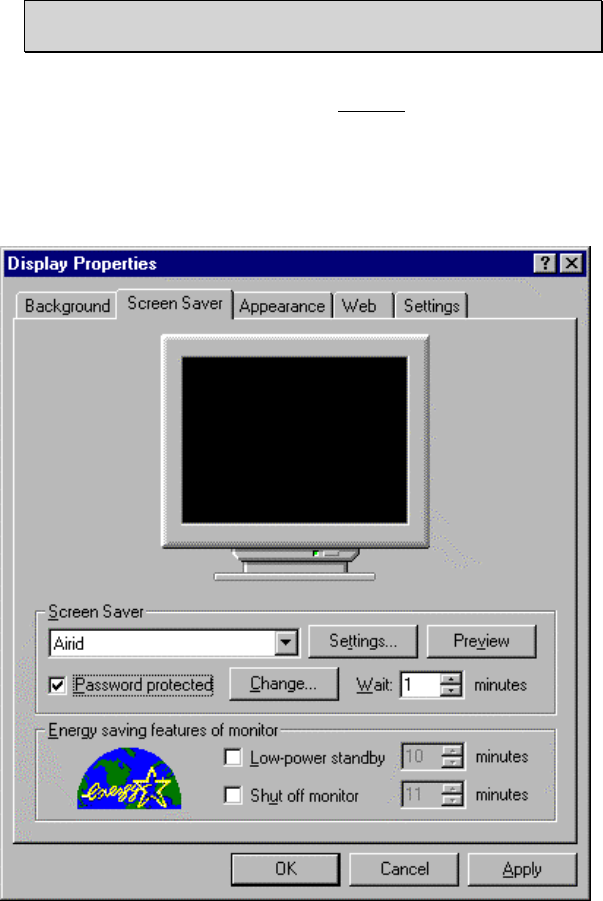
Software Setup 20
RF IDeas
Note: If the Password Protected box is not selected, user
can gain access without a badge or password.
9. The Preview buttons is not supported at this time.
10. The Wait field sets the number of minutes the
mouse/keyboard will be inactive before launching the
screensaver. This Windows parameter value will determine
how soon the system will become secure once you leave your
PC. Windows defaults to a minimum of one (1) minute delay.

21 Software Setup
AIR ID
NOTE: The AIR ID software provides a function to set this delay in
seconds and allows settings as low as 10 seconds. This is very
useful for providing a timely proximity activated system. There are
two important things to be aware of when choosing to use the AIR
ID delay:
1. Every time you click OK in the Control Panel’s screensaver
dialog box, the Windows delay (in minutes) is sent to the
operating system thus resetting the AIR ID setting. Therefore
you will need to use the AIR ID software in order to reset this
parameter in seconds or to a value less than one minute.
2. The lower you set this value, the shorter the period of time the
PC is exposed when you step away and this increases the
security of the desktop. Lowering this value does require the
badge to respond more often and this will affect the life of your
AIR ID battery.
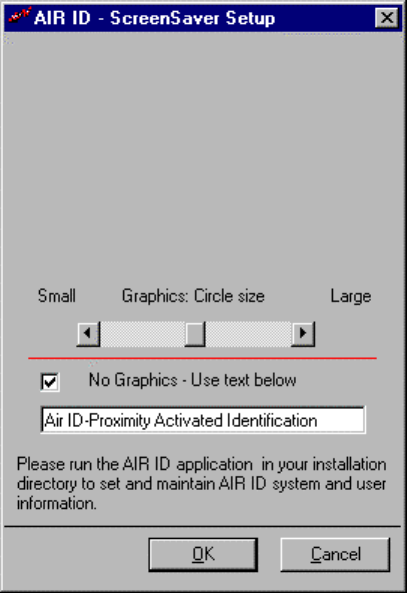
Software Setup 22
RF IDeas
Click the Settings button and the AIR ID setup screen will appear.
This screen will allow you to modify the settings related to the
graphical aspects of the screensaver. Use the slide bar to modify
the size of the circles.
If you prefer to have a scrolling text message displayed, click the
Checkbox labeled “No Graphics - Use Text Below”. Enter the
appropriate message in the field beneath the checkbox. This
message is then scrolled during screensaver operation.
The user may select their own bitmap file however since the
screen saver tab is locked for security reasons, this choice is
made in the AIR ID application (see below).
All other settings related to the user(s), passwords, and proximity
settings are described in the next section.
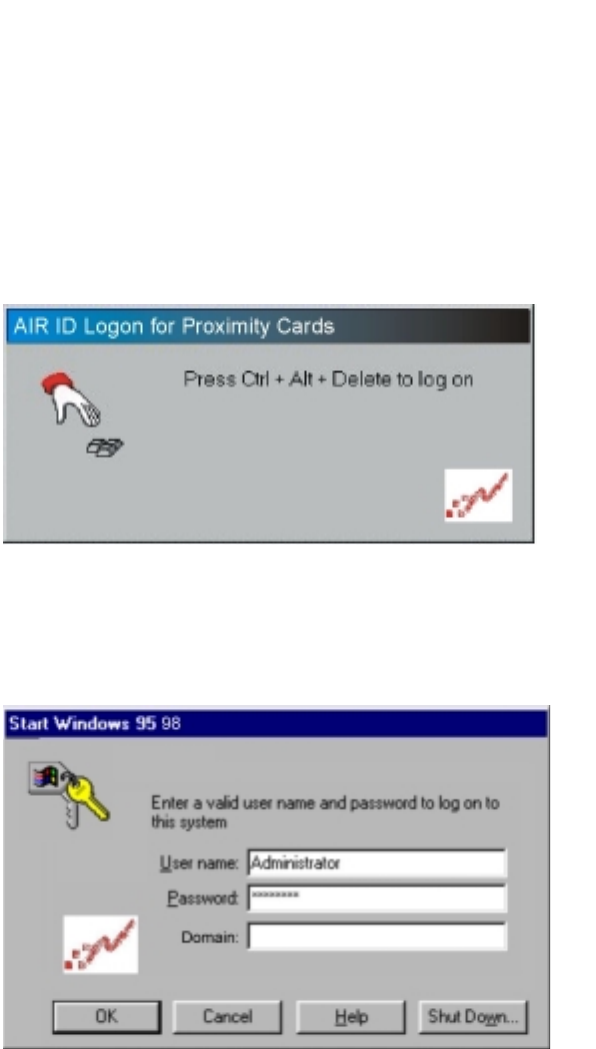
23 Software Setup
AIR ID
Windows 95B/98 Security Layer Operation
The release of the Windows 95/98 security layer brings NT style
security the Windows 95/98 environments. Previously users could
simply press the ESC key and gain access to a desktop computer
running under the Windows 95/98 operating system.
Using the AIR ID Windows 9x security layer, users are now
required to logon using either a manual password, their proximity
card, or both. The logon is accomplished using a Ctrl-Alt-Del
keystroke sequence, similar to Windows NT/2000.
Once you press Ctrl-Alt-Del you are presented with a logon dialog
box requesting your username, password, and domain credentials.
It is important to understand that AIR ID does not perform the
authentication. The operating system or the authentication server
provides this functionality.
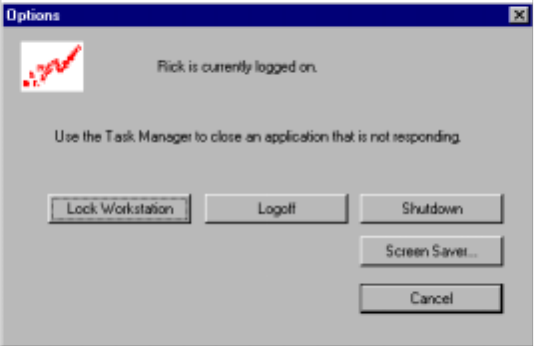
Software Setup 24
RF IDeas
After the logon sequence is accepted, the user is presented with
their desktop. Pressing the Ctrl-Alt-Del sequence will allow the
user to select their own BMP (bitmap) file for the screen saver to
display when the desktop goes into a locked state.
The self-locking screensaver is integrated into this security layer.
In the locked mode, all applications are left in memory and
executing as before. A screen saver bitmap file is displayed and
the keyboard and mouse are locked. The proximity card can be
set to be auto-detected, and the desktop is returned. Alternately,
the user may enter their credentials manually or an administrator
may present an admin override (described below) badge.
Once the logon credentials are presented (either manually or via
the proximity token) the local and network connections are
established.
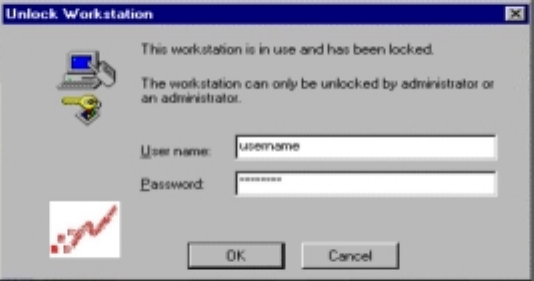
25 Software Setup
AIR ID
Setting AIR ID System Parameters
The AIR ID Setup software is found by using the Windows START
button located on your desktop. From there select Programs and
locate the AIR ID folder. In the AIR ID folder, you will find the
Readme file together with the AIR ID application and other related
files. Select the AIR ID application to begin setting the various AIR
ID parameters.

Software Setup 26
RF IDeas
AIR ID Startup Screen (First Time Users)
If this is your first time running the application, or you have chosen
not to disable the Startup Screen, you will see the AIR ID Startup
Screen. This screen is intended for first time users.
Step 1 - Enter the COM Port on which the AIR ID base unit is
attached. This function will test the communication with the base
unit. If the AIR ID software cannot communicate with the base unit,
an error message will be displayed. If an error occurs, check that
the Base Unit is properly attached to the system and the correct
port number is being used.
Step 2 – Set Admin Password – All AIR ID systems ship with the
Admin password set to ‘12345678’. For security reasons, change
this password to a new value. Be sure to remember this value or
store in a secure location.
Step 3 – Add User – Add the username, domain (if no domain
leave blank), badge address (located on back of the AIR ID badge
for non-pcProx products), password and two-factor options.
pcProx product users must use the "Learn" button with their card

27 AIR ID Application (Standard Launch)
AIR ID
on the reader to enter the badge address. If you have selected
the enterprise installation, you must also select the appropriate
machines to which this user will be allowed hands free access.
NT users must use the same NT username, domain, and
password as currently used in the NT User Manager or Domain
Manager.
Step 4 – AIR ID Settings – This step allows you to test your
badge. Use the controls to select your user name. You can then
use the Check button to test the communication to the badge. A
green visual badge indicator shows that the badge was read. A
red indicator shows that the badge was improperly read. You can
select the Continuous button and then select the Check button to
perform repeated reads. This allows you to see how well your
badge is being read in your workspace.
Show this Startup Screen (Check Box) – This check box is
located in the upper right hand corner of the Startup Screen. If
you would like to disable the Startup Screen for future launches,
clear the checkbox labeled Show this Startup Screen. If you
would like to reactivate this screen in the future, use the similar
checkbox found under the About tab located in the standard AIR
ID application. Press the Exit Initial Setup button located at the
bottom, and proceed to the next section
Exit Initial Settings - This button will exit you from the AIR ID
Startup Screen and launch the normal AIR ID application front
end.
AIR ID Application (Standard Launch)
Once the Show Startup Screen check box has been disabled or
the Exit Initial Settings button has been selected, the AIR ID
application will use its standard launch. This mode allows direct
entry of program options and more detailed options for the
application. These options are described in the next section.

Base Unit Dialog Tab 28
RF IDeas
Base Unit Dialog Tab
The Base Unit tab allows all Base Unit options to be set. The
Range and sensing options are greyed out since these apply to
only the active card/reader solutions. The COM Port setting, WAIT
times, and version described in detail in this section.
Base Unit Com Port
Before adding user(s) and badge(s) to the system, set the Base
Unit parameters (if not already set) by typing the Com Port number
which the AIR ID Base Unit is attached: 1 for COM1, 2 for COM2
etc.
If you experience problems with the COM port setting you may
need to check:
1. The port is not overtaken by software such as Palm Pilot’s
Hot Sync, or
2. The Base Unit is powered up (mouse/keyboard
connection) and attached to correct the COM Port
connection.
You may verify this communication is correct by reading the
version of the Base Unit. Press the button labeled Get Base
Version. The three boxes to the right of the button will display the

29 Base Unit Dialog Tab
AIR ID
version of firmware located within the Base Unit. If you receive an
error message, you will need to verify the connection between the
PC and Base Unit and make sure you are selecting the proper
COM port.
Get Base Version
Pressing this button will cause the software to read the Base Unit
directly. This is useful for:
1. Technical support issues
2. Verifying the Com Port is attached correctly
3. Verifying the Com Port is open for communication and not
being used by another application
4. Verifying the Base Unit is working properly
Screen Saver Wait Time (seconds)
Like any screensaver under Windows 95/98/NT, the screensaver
is launched when there is no keyboard or mouse activity for the
period of the specified WAIT time. As mentioned earlier, the
WAIT time can be set both using Windows Display Settings and
using the AIR ID application and thus cause some confusion. Both
methods affect the value the screensaver uses to determine its
launch countdown. Any modifications to the Windows Display
Properties will reset the value to the time set in Display
Properties/Screensaver/Wait setting. Therefore, always use the
AIR ID program to reset the wait settings after modifying any
Display Properties items.
The Wait time can be set to a minimum of 10 seconds. Remember
that the lower the Wait setting, the more Badge will respond and
thus the shorter the battery life. We recommend using a 15-30
second setting as a good starting point. If this time is too long in
your environment, set this Wait time to its minimum value of 10
seconds.
Note: The Windows Wait time is entered in minutes while the AIR
ID Wait time is entered in seconds.
Once this WAIT period has elapsed, the AIR ID screensaver is
launched by the operating system. Before the screen is blanked,
AIR ID checks the defined proximity area for a valid authorized
Badge. If one is found, the screensaver execution is terminated
immediately and control is returned to the user. In Windows 95/98
you will notice the cursor turns to an hourglass briefly during this
Base Unit Dialog Tab 30
RF IDeas
checking procedure. If no valid badge is detected, the display,
keyboard and mouse are secured while the Ctrl-Alt-Del (and on
the newer keyboards, the special Windows key) are disabled until
a valid user Badge is found, or valid password is entered.
Screen Saver Wait Time when no Base Unit
Attached
This option allows a second wait time to be used when AIR ID
detects the Base Unit has not been attached. This setting is
convenient for docking station users who bring their notebook
computers home or on the road and do not require the security of
AIR ID. AIR ID will use this alternate wait time so that the
screensaver is not activated so aggressively when manual entry is
required due to no Base Unit being attached.
The option is entered in seconds. For a setting of 10 minutes
before the screensaver is launched enter 600 (seconds).
Once a key on the keyboard is pressed, or the mouse is moved
and no valid Badge is detected, you will receive a Password
Dialog Box. This permits you to manually enter a valid password
and gain access to the system If the two-factor option has not
been selected.
Select Screen Saver Bitmap
This allows the user to customize their screen saver bitmap
choice. Use this button to browse to the bitmap (filename.BMP
file) of choice. Your bitmap file will be displayed when the screen
saver is launched. This bitmap will bounce around the display
depending on its size. Note: there are some non-standard bitmap
formats. These are not supported. Several shareware graphics
applications are available that allow you to convert to a standard
BMP format.

31 Badges Dialog Tab
AIR ID
Badges Dialog Tab
The Badge(s) Tab allows the adding, deleting and editing of
users. This function also allows the badges to be tested for proper
operation. Functions within this tab help the user adjust the
orientation of the base. All functions are described in this section.
Overview
All AIR ID screensaver systems have a database that holds user
information. The Badge(s) Dialog Tab is a convenient screen to
view user information and test the badge’s RF characteristics in
your environment. A Visual Badge Indicator is shown to assist the
user in testing the badge to base unit communications.
Types of Users
There are three types of users in the AIR ID system:
Administrative Users
There is one administrative user (Username is “admin”), permitted
in the AIR ID system. This user has the ability to add, delete and
edit users on the system as well as modify other system settings.
The “admin” user may also have proximity badge capability if
initialized with the [Admin Tools]-[Admin Badge] facility.

Badges Dialog Tab 32
RF IDeas
The ADMIN user has the ability to gain access to an active login
session, therefore the software is always scanning for more than a
single user during the login session. Please refer to the 'Admin
Badge' facility under 'Admin Tools'.
Non-Badge Users
You are permitted to add other users to the system who are not
yet using AIR ID badges.
AIR ID Badge Users
These users may gain access to the system using either their
badge or manual password entry. If the two-factor option is
selected then the badge and password, or password-only is
required in order to gain entry. Note there is a feature that permits
the user to required both the password and badge (Forced Two-
Factor mode). To enable this feature you must contact RF IDeas
directly or email Techsupp@RFIDeas.com.
TIP: If you are the only user on your system, you should set your
“admin” password to the same as your user password to avoid
confusion.
Set (Changing) Password
To change password, click on the SetPswd button. A change
password dialog box will appear. Enter your Old Password, type
your New Password, and Confirm Password. On NT/2000, this
will change your password in AIR ID as well as change the
password at the NT server. Win9x users must synchronize the
system user password with the AIR ID password through the User
Manager application.
To register the changes click the Set button.
Check
This button allows you to read a user’s badge to:
• Verify the Base Unit is working
• Verify the Badge at the reader is assigned to the user shown
in the field.

33 Badges Dialog Tab
AIR ID
Reading a Badge
1. Select a user from the database using the record selectors, on
both sides of the field AIR ID Users (the record selectors look
similar to those found on your VCR).
2. Once you have the user’s name shown in the User field, click
on the Check button. This will cause the Base Unit to
request the ID from the selected user’s Badge.
Once you select the Continuous checkbox, the Base will read at
approximately once every two seconds.
If the Badge is read successfully, the Visual Badge Reader will
be displayed as a GREEN box.
If the Badge is not detected, the Visual Badge Reader will be
displayed as a RED box. If this occurs, you may have an incorrect
badge, the badge is located out of the range of the Base Unit, the
proximity badge is defective, or there were errors indicating the
connection with the Base Unit is incorrect.
NOTE: You can cause the Base Unit to continuously read the
Badge by first selecting the checkbox labeled Continuous, and
then pressing the Check button. To stop the continuous reading
mode, de-select the Continuous checkbox.
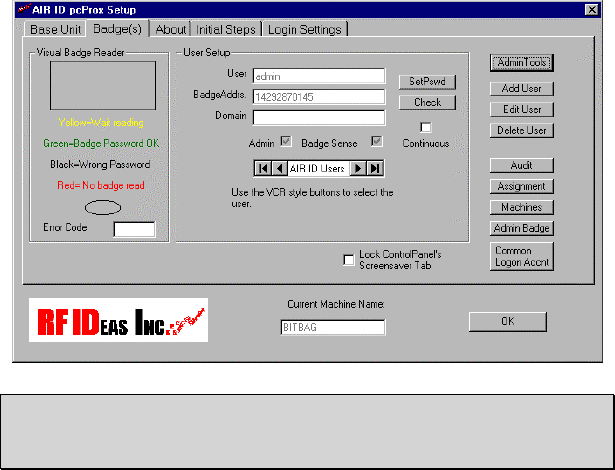
Badges Dialog Tab 34
RF IDeas
Administrative Functions
To gain access to the administrative buttons you need to enter the
AIR ID admin password. Press the [Admin Tools] button and enter
the admin Password.
A valid admin password yields the following screen:
NOTE: Since all AIR ID system ship with the same ‘ADMIN’ user’s
password (12345678), make sure you change this password in
order to maintain the security of the system.
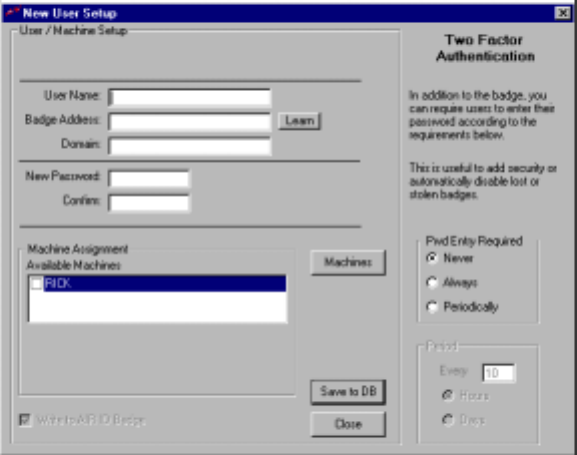
35 Badges Dialog Tab
AIR ID
Add User
There are two methods available for adding users to the system.
The user may auto-enroll themselves provided they know their
username, password, and optionally domain. This is done
automatically at boot-up provided they have their proximity card on
the reader, and use a valid logon credential. Once the user enters
this information, they will see a dialog box which asks if they would
like to be added to the AIR ID database.
Alternately, the admin may enroll the use using this ‘Add User’
feature.
Using the supplied field, enter the user’s logon Username,
Password, and Domain into the corresponding fields.
The ‘Learn’ button is located next to the Badge Address field. This
will read the Badge Address of your compatible proximity badge.
The badge ID that is read into the field will not correspond to the
ID printed on the card. This is normal – don't try to change the
'Learned' ID.

Badges Dialog Tab 36
RF IDeas
NOTE: For 95/98NT Users, make sure that the Username and
Password entries are identical to those used for the respective
operating system. The new user added to the AIR ID system will
not be detected (logon or screensaver) until the PC is rebooted.
If you want to add a temporary user or user without a Badge, leave
the Badge Address field empty.
TD2F TM - TD2F, time definable two-factor authentication, is a
great feature to either balance security and convenience, increase
security, or provide protection against lost or stolen badges. If a
badge is used to gain access the admin can set up users such that
they will need to enter their passwords always, never, or
periodically. The configuration for this setting is that the user can
always get in with their password (the badge is not a forced
requirement). If you would like to force both password and badge,
please contact your AIR ID supplier to understand how to set this
up safely.
AIR ID includes a provision for Two-Factor Authentication. When
enabled, this feature requires the user to provide a password
(manual) entry as specified by the Pwd Entry Required selection.
This feature is useful for those concerned about lost or stolen
badges. It is also a great setting for administrator users who want
to benefit from the stronger two-factor security. This feature can be
set to Never, Always, or Periodically.
The Period choices are enabled once the Periodically radio button
is chosen. The password is then required periodically according to
the selections in the Period box.
The Period duration is selected with the value in the Every field.
The Every field applies to either the Hours or Days radio button
selection.
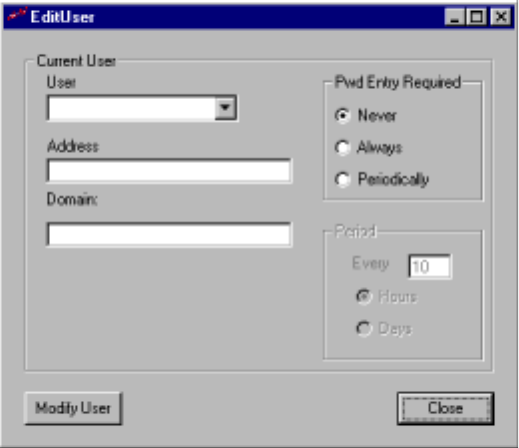
37 Badges Dialog Tab
AIR ID
Edit User
The Edit User screen is used to modify Two-Factor Authentication
parameters or the default Domain used by NT users. Once the
parameters are modified, use the Modify User button to register
the changes.

Badges Dialog Tab 38
RF IDeas
Delete User
Select the User you want to delete by using the VCR style buttons
and then click on Delete User. Another dialog box will appear
stating, “You are about to Delete a user, do you want to continue?”
Make your selection.
NOTE: If you feel an authorized badge is lost or stolen, simply
have the administrative user remove the lost badge user from the
system by using the Delete button.
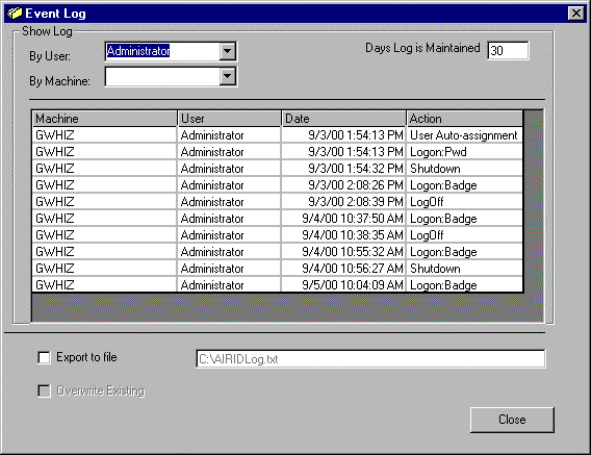
39 Badges Dialog Tab
AIR ID
Audit Log
The Audit Log button provides the administrator with the ability to
track user activity on the system, including the auditor’s activity.
Pressing this button brings up the Audit Log screen as shown
below.
The audit information may be listed by Machine or by User.
Choosing the appropriate pull down button makes the selection.
You may export the log information by first typing in the path and
file name, and then selecting the “Export to file” check box. Once
you select this option, you may choose the By User or By Machine
name selection and the output file will be created and / or
appended to. If the "Overwrite Existing" box is checked, previous
data in the specified file will be overwritten, otherwise the new data
set will be appended to the existing data. The data is exported in
a CSV (Comma Separated Variable) format.
Badges Dialog Tab 40
RF IDeas
Audit
The AIR ID system currently logs the following events:
1. Change Password
2. Change Password: Failed
3. Logon Badge
4. Logon Badge Fail
5. Logon Pwd
6. Logon Pwd Failed
7. Logoff
8. Shutdown
9. User Auto-assignment
10. Manual Lock
11. Manual Unlock
12. Manual Unlock Failed
13. Badge Unlock
14. Badge Unlock Failed
15. Assignment [of a user to a machine]
16. Admin Badge Override
17. Admin Manual Override
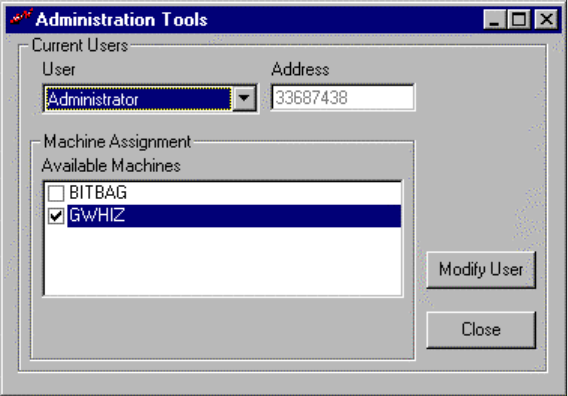
41 Badges Dialog Tab
AIR ID
Assignment
This screen allows you to assign user access rights to various PCs
throughout the organization. Select and highlight the username
using the drop down select box. Shown in the Machine
Assignment box are the available machines (standard PC naming
convention used) to which this user can be assigned access.
A check indicates this user has access to this particular PC. Once
you have all the selections made, press the Modify User button to
register the changes. If there are additional machines not listed in
the Machine Assignment box you need to add, install the AIR ID
system on those machines and they will automatically be
registered (assuming the DBLocation is identical).
The user 'admin' is assigned to all machines and cannot be altered
with this dialog.

Badges Dialog Tab 42
RF IDeas
Machines
This button allows the administrator to delete PC machines in the
organization to the AIR ID system. The AIR ID system will
automatically add your machine name to the list when the AIR ID
software is installed.
Each PC will show its Machine Name in the box labeled: Current
Machine Name.
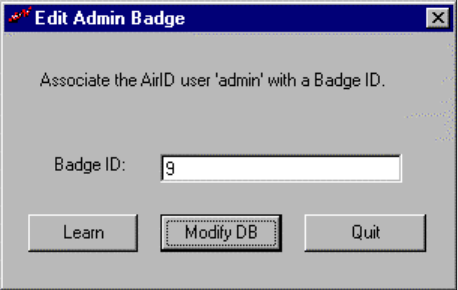
43 Badges Dialog Tab
AIR ID
Admin Badge
Use this dialog to change the Badge ID associated with the
ADMIN user. The ADMIN badge is always actively scanned and is
useful to gain access to active login sessions as well as locked
workstations. Be aware, this allows access to the locked desktop
without actually logging off the user. The access is logged as an
AdminOverride event in the Audit Log.
Passive badge users should use the 'Learn' button to enter the
Badge ID.
Badges Dialog Tab 44
RF IDeas
Screensaver Lock
AIR ID permits the administrator to lock the Control Panel’s access
to the screensaver tab. This prevents the user from deselecting
screensaver operation or modifying the WAIT time.
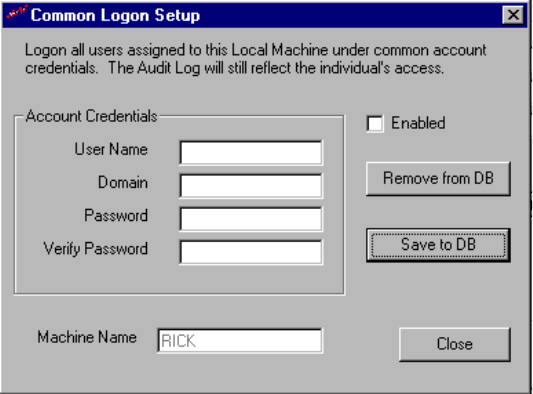
45 Badges Dialog Tab
AIR ID
Common Logon
The Common Logon feature allows several users to share
applications using a single logon account. This is efficient since
there is no need to close applications and re-logon each time a
different user needs access to the machine.
The admin enters established W9x/NT user account credentials
into the fields shown above. All users who logon to this machine
will actually logon using this shared account. The Save to DB
button records the entry. The Audit Log will however show that
individual actually using the machine along with a date/time stamp.
The Enable checkbox allows the admin to quickly enable or
disable this feature without having to re-enter the account
credentials to re-enable the feature. This setting will take place
after the‘reboot’ or,
‘close all programs and login as a new user’
function is performed from the ‘Shut Down’ Windows button.
Use the Remove button to completely remove the account
credentials from the AIR ID system.
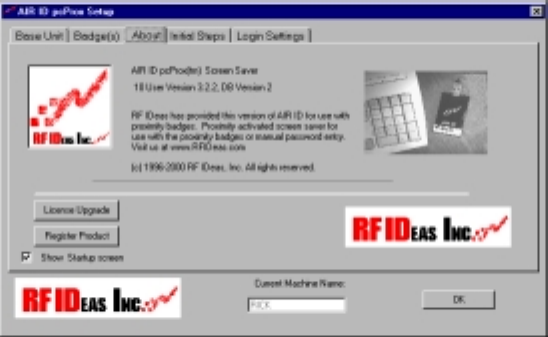
About Dialog Tab 46
RF IDeas
About Dialog Tab
This screen allows you to re-enable the initial Start-up screen and
perform a User License Upgrade. The License Upgrade button
allows the user to increase the license count of centrally managed
users. You will need to call your vendor to purchase additional
licenses and obtain the software upgrade key.
Once you obtain the key, enter your Company Name and the Key
in the fields. You may use the Verify button to ensure the key
corresponds to the License Count you purchased. Note the
License is not additive to the current number of user licenses.
Once you press Upgrade, the license is set and will be in effect at
the next logon.
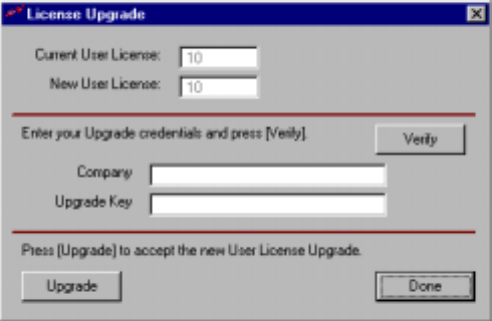
47 About Dialog Tab
AIR ID
The Register Product button provides a web link to a registration
should the original form be misplaced. The About Tab also
displays valuable version information that is required for technical
support.
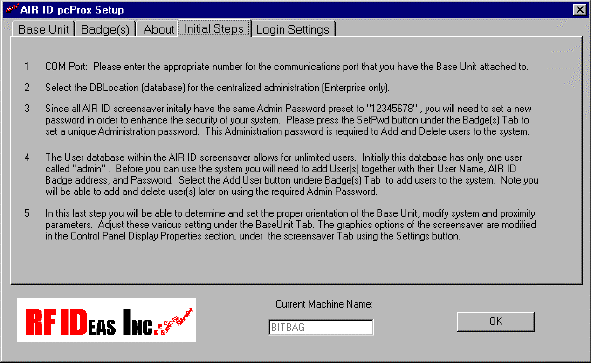
Login Settings Dialog Tab 48
RF IDeas
Initial Steps Dialog Tab
This screen displays a summary of the initial Start-up steps that
appeared when the AIR ID application was first launched.
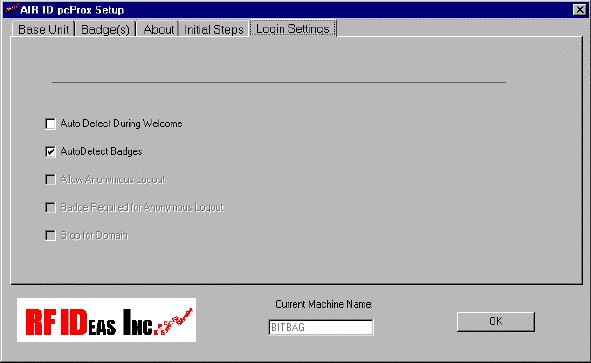
49 Login Settings Dialog Tab
AIR ID
Login Settings Dialog Tab
AutoDetect During Welcome - This permits hands-free badge
detection at the initial login session by not stopping at the
'Welcome' screen if a badge is present.
AutoDetect Badges- Allows polling of the badge for complete
hands-free (contact-less for pcProx users) operation at the first
logon screen (after the Welcome screen). Disabling this feature
will force a manual credential entry at Logon.
Allow Anonymous Logout – Permits anyone to logout the
currently logged in user. If this is not selected, only the current
‘logged in’ user can perform the logout function
Badge Required for Anonymous logout – An AIR ID Badge,
authorized on this PC, is required for this operation.
Stop For Domain – Select this feature to stop the automatic logon
process at boot-up, providing you with an opportunity to enter a
different Domain than that stored in the AIR ID database. The
username and password will be automatically entered by the
GINA. Note that in order for this function properly to work, the
username and password must be the same for all Domains.
Login Settings Dialog Tab 50
RF IDeas
NT GINA
Under NT, RF IDeas does not replace the system GINA. Rather
the RF Ideas GINA uses a threading GINA which works with the
GINA specified to the operating system. This threading preserves
the functionality intended by the originating GINA. Some vendors
supply a replacement GINA and this removes the functionality of
an existing GINA. Should you install an application that removes
the AIR ID GINA you will need to uninstall AIR ID and reinstall it
again. This will not hard the other application since the AIR ID
GINA will thread to this new GINA.
51 TROUBLESHOOTING
AIR ID
TROUBLESHOOTING
If your system is not working it could be for one of the following
reasons:
No Base Unit Attached
1. Check to be sure the base unit is plugged in.
2. Verify the COM Port selected agrees with the connector
on the PC. Refer to the section labeled Get Base Version
and review this step.
3. Verify no application has taken control over the COM Port.
Applications such as Palm Pilot’s Hot Sync program will
take over the COM Port and not release it until you
terminate them. Most applications like this allow you to
specify their operation on a manual installation basis.
Cannot Locate the Badge
1. It could be the wrong badge
2. The badge is not in the database
3. Badge is out of the proximity range
Your Password doesn’t work
1. Your NT password, username, or Domain is different than the
one used in the AIR ID system.
If you are still experiencing problems, contact RF IDeas Technical
support dept:
(888) 542-4743 (8:30 - 5:30 Central Time).

Index 52
RF IDeas
TECHNICAL SPECIFICATIONS
The AIR ID System was developed with an open architecture
designed to allow for further integration. The API Software will be
provided to system integrators via The AIR ID Developer Kit.
The AIR ID Base Unit
916 MHz transceiver
Microprocessor
DB9 Connector
Approximately 3.75”x2.5”x1”
FCC ID M9MBU100
The AIR ID Badge
916 MHz transceiver
Microprocessor
Coin Cell Lithium Battery (CR2025)
Credit Card Size
Approximately 3”x2”x1/5”
FCC ID M9MMU100
The pcProx Base Unit
Proximity reader compatible with HID or Motorola Indala
badges.
Microprocessor
DB9 Connector
Approximately 3.75”x2.5”x1”
FCC ID M9MBUPCPROXH100 or M9MPCPROXM100
53 Index
AIR ID
Index
A
About.............................. 27
Add User ........................ 35
admin ........................32, 34
ADMIN.................31, 32, 34
Administrative ............31, 34
Allow Anonymous Logout
................................... 49
Assignment..................... 41
Audit Log ........................ 39
AutoDetect Badges........ 49
AutoDetect during
Welcome .................... 49
B
Badge Address................ 36
Badges Dialog Tab ........ 31
Base Unit Com Port28. See
COM Port
battery............................ 21
biometric......................... 12
C
Check........................32, 33
COM1........................16, 28
Confirmation Password.... 32
Continuous.................... 33
Control Panel .................. 19
CR2025 .......................... 52
D
DBLocation..................... 41
Delete User..................... 38
Domain........................... 37
E
Edit User......................... 37
Exit Initial Setup ............ 27
Export audit log............... 39
G
Get Base Version28, 29, 51
GINA.........................14, 50
Graphics........................ 22
K
Keyboard/Mouse ............. 19
L
Logon............................. 40
M
Machine Name................ 42
Machines........................ 42
Modify User..............37, 41
O
Old Password ................. 32
P
Password ....................... 32
Password Protected ...... 19
Preview.......................... 20
R
requirements................... 15
Room Proximity............... 19
S
serial port ..................15, 16
SetPswd ........................ 32
smart cards..................... 12
Startup Screen................ 27
T
Two-Factor Authentication
..............................36, 37
U
uninstall.......................... 18
username ....................... 41
Users ..... See Administrative
V
Visual Badge Reader..... 33
Index 54
RF IDeas
WWait .................... 19, 20, 29